tyre pressure PEUGEOT 5008 2012 Owners Manual
[x] Cancel search | Manufacturer: PEUGEOT, Model Year: 2012, Model line: 5008, Model: PEUGEOT 5008 2012Pages: 340, PDF Size: 16.42 MB
Page 28 of 340
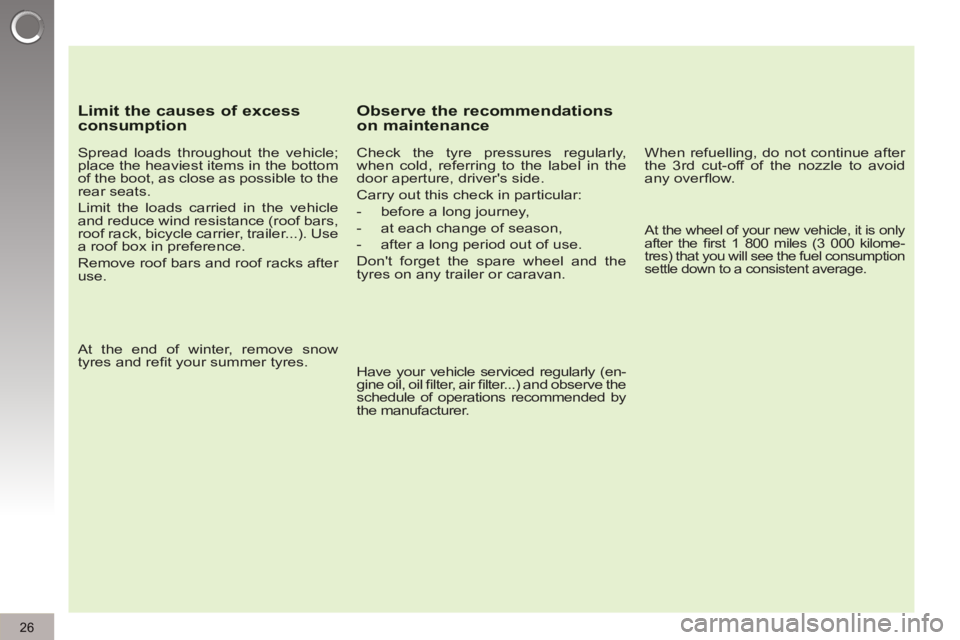
Limit the causes of excess consumption
Spread loads throughout the vehicle;
place the heaviest items in the bottom
of the boot, as close as possible to the
rear seats.
Limit the loads carried in the vehicle
and reduce wind resistance (roof bars,
roof rack, bicycle carrier, trailer...). Use
a roof box in preference.
Remove roof bars and roof racks after
use.
At the end of winter, remove snow
tyres and refi t your summer tyres.
Observe the recommendationson maintenance
Check the tyre pressures regularly,
when cold, referring to the label in the
door aperture, driver's side.
Carry out this check in particular:
- before a long journey,
- at each change of season,
- after a long period out of use.
Don't forget the spare wheel and the
tyres on any trailer or caravan.
Have your vehicle serviced regularly (en-
gine oil, oil fi lter, air fi lter...) and observe the
schedule of operations recommended by
the manufacturer.
When refuelling, do not continue after
the 3 rd cut-off of the nozzle to avoid
any overfl ow.
At the wheel of your new vehicle, it is only
after the fi rst 1 800 miles (3 000 kilome-
tres) that you will see the fuel consumption
settle down to a consistent average.
26
Page 35 of 340
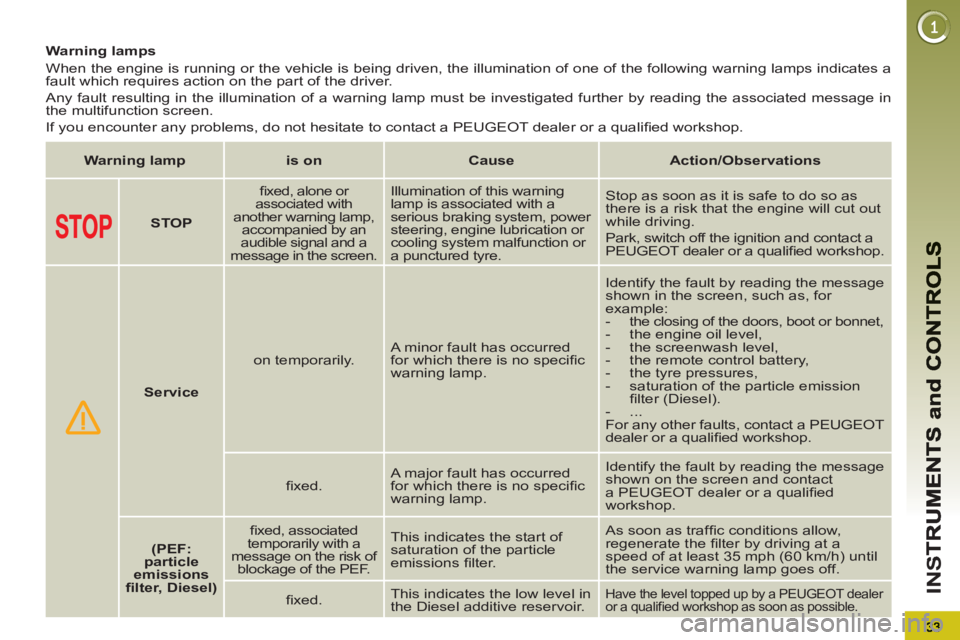
IN
S
Warning lamps
When the engine is running or the vehicle is being driven, the illumination of one of the following warning lamps indicates a
fault which requires action on the part of the driver.
Any fault resulting in the illumination of a warning lamp must be investigated further by reading the associated message in
the multifunction screen.
If you encounter any problems, do not hesitate to contact a PEUGEOT dealer or a qualifi ed workshop.
Warning lamp
is on
Cause
Action/Observations
STOP
fi xed, alone or
associated with
another warning lamp,
accompanied by an
audible signal and a
message in the screen.
Illumination of this warning
lamp is associated with a
serious braking system, power
steering, engine lubrication or
cooling system malfunction or
a punctured tyre. Stop as soon as it is safe to do so as
there is a risk that the engine will cut out
while driving.
Park, switch off the ignition and contact a
PEUGEOT dealer or a qualifi ed workshop.
Service
on temporarily. A minor fault has occurred
for which there is no specifi c
warning lamp. Identify the fault by reading the message
shown in the screen, such as, for
example:
- the closing of the doors, boot or bonnet,
- the engine oil level,
- the screenwash level,
- the remote control battery,
- the tyre pressures,
- saturation of the particle emission
fi lter (Diesel).
- ...
For any other faults, contact a PEUGEOT
dealer or a qualifi ed workshop.
fi xed. A major fault has occurred
for which there is no specifi c
warning lamp. Identify the fault by reading the message
shown on the screen and contact
a PEUGEOT dealer or a qualifi ed
workshop.
(PEF:
particle
emissions
fi lter, Diesel)
fi xed, associated
temporarily with a
message on the risk of
blockage of the PEF. This indicates the start of
saturation of the particle
emissions fi lter. As soon as traffi c conditions allow,
regenerate the fi lter by driving at a
speed of at least 35 mph (60 km/h) until
the service warning lamp goes off.
fi xed. This indicates the low level in
the Diesel additive reservoir.
Have the level topped up by a PEUGEOT dealer
or a qualifi ed workshop as soon as possible.
Page 39 of 340
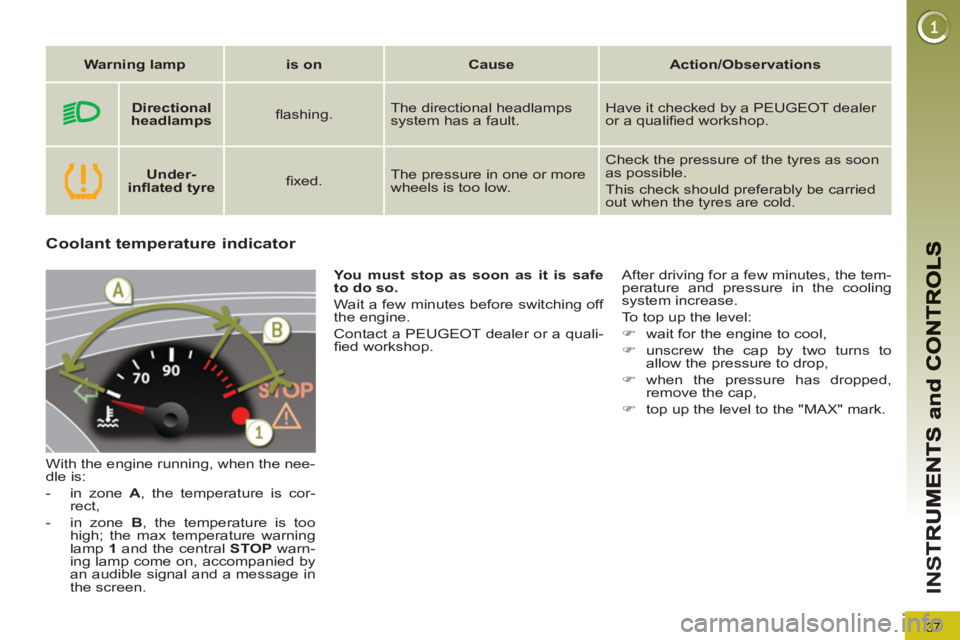
37
IN
S
Coolant temperature indicator
With the engine running, when the nee-
dle is:
- in zone A
, the temperature is cor-
rect,
- in zone B
, the temperature is too
high; the max temperature warning
lamp 1
and the central STOP
warn-
ing lamp come on, accompanied by
an audible signal and a message in
the screen. After driving for a few minutes, the tem-
perature and pressure in the cooling
system increase.
To top up the level:
�)
wait for the engine to cool,
�)
unscrew the cap by two turns to
allow the pressure to drop,
�)
when the pressure has dropped,
remove the cap,
�)
top up the level to the "MAX" mark.
You must stop as soon as it is safe
to do so.
Wait a few minutes before switching off
the engine.
Contact a PEUGEOT dealer or a quali-
fi ed workshop.
Warning lamp
is on
Cause
Action/Observations
Directional
headlamps
fl ashing. The directional headlamps
system has a fault. Have it checked by a PEUGEOT dealer
or a qualifi ed workshop.
Under-
infl ated tyre
fi xed. The pressure in one or more
wheels is too low. Check the pressure of the tyres as soon
as possible.
This check should preferably be carried
out when the tyres are cold.
Page 131 of 340
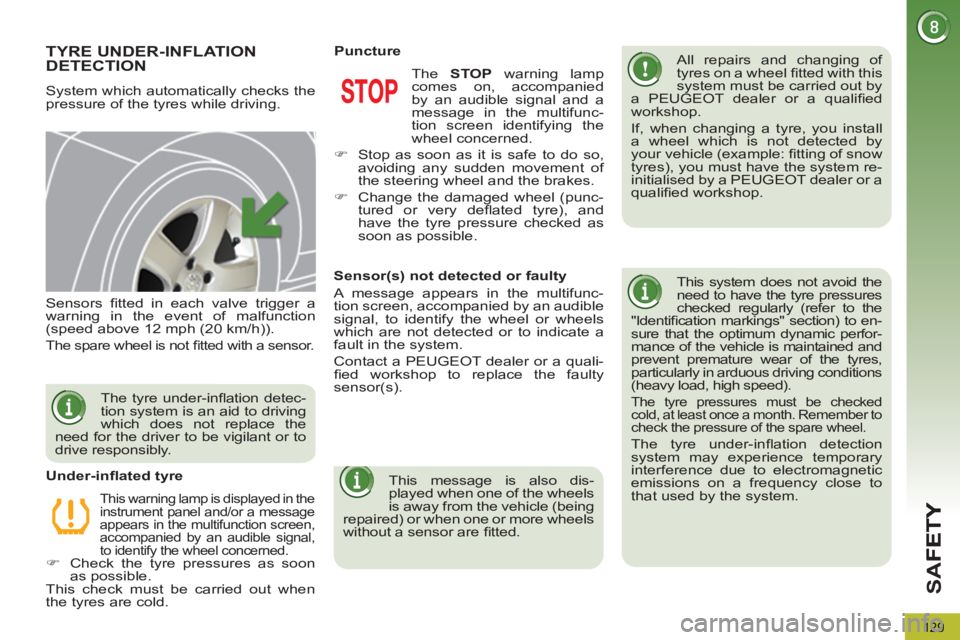
SA
F
129
TYRE UNDER-INFLATION DETECTION
System which automatically checks the
pressure of the tyres while driving.
All repairs and changing of
tyres on a wheel fi tted with this
system must be carried out by
a PEUGEOT dealer or a qualifi ed
workshop.
If, when changing a tyre, you install
a wheel which is not detected by
your vehicle (example: fi tting of snow
tyres), you must have the system re-
initialised by a PEUGEOT dealer or a
qualifi ed workshop.
This system does not avoid the
need to have the tyre pressures
checked regularly (refer to the
"Identifi cation markings" section) to en-
sure that the optimum dynamic perfor-
mance of the vehicle is maintained and
prevent premature wear of the tyres,
particularly in arduous driving conditions
(heavy load, high speed).
The tyre pressures must be checked
cold, at least once a month. Remember to
check the pressure of the spare wheel.
The tyre under-infl ation detection
system may experience temporary
interference due to electromagnetic
emissions on a frequency close to
that used by the system.
Sensors fi tted in each valve trigger a
warning in the event of malfunction
(speed above 12 mph (20 km/h)).
The spare wheel is not fi tted with a sensor.
This warning lamp is displayed in the
instrument panel and/or a message
appears in the multifunction screen,
accompanied by an audible signal,
to identify the wheel concerned.
�)
Check the tyre pressures as soon
as possible.
This check must be carried out when
the tyres are cold.
Under-infl ated tyre The STOP
warning lamp
comes on, accompanied
by an audible signal and a
message in the multifunc-
tion screen identifying the
wheel concerned.
�)
Stop as soon as it is safe to do so,
avoiding any sudden movement of
the steering wheel and the brakes.
�)
Change the damaged wheel (punc-
tured or very defl ated tyre), and
have the tyre pressure checked as
soon as possible.
Puncture
The tyre under-infl ation detec-
tion system is an aid to driving
which does not replace the
need for the driver to be vigilant or to
drive responsibly.
Sensor(s) not detected or faulty
A message appears in the multifunc-
tion screen, accompanied by an audible
signal, to identify the wheel or wheels
which are not detected or to indicate a
fault in the system.
Contact a PEUGEOT dealer or a quali-
fi ed workshop to replace the faulty
sensor(s).
This message is also dis-
played when one of the wheels
is away from the vehicle (being
repaired) or when one or more wheels
without a sensor are fi tted.
Page 132 of 340
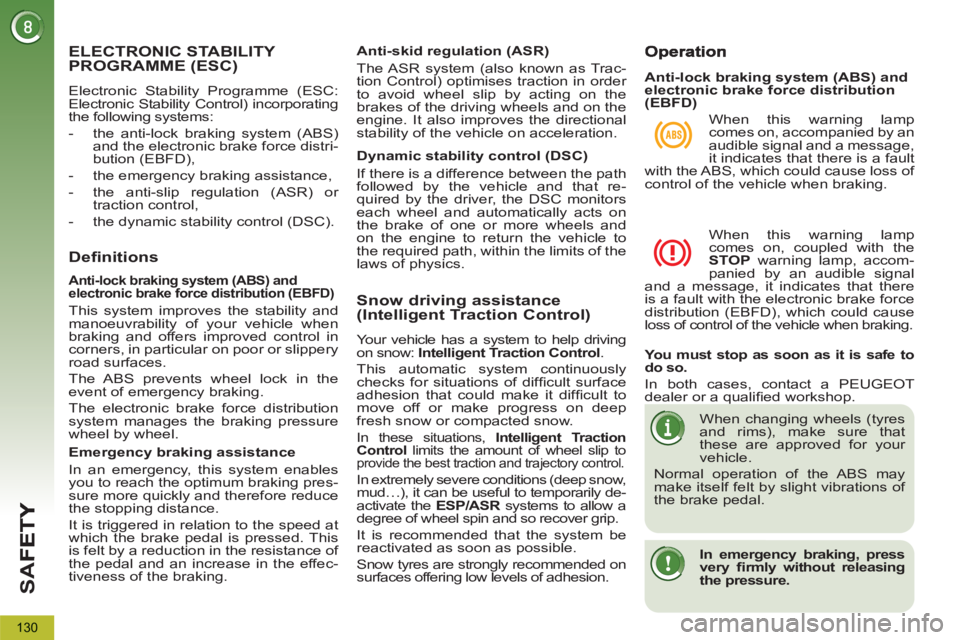
SA
F
130
ELECTRONIC STABILITY PROGRAMME (ESC)
Electronic Stability Programme (ESC:
Electronic Stability Control) incorporating
the following systems:
- the anti-lock braking system (ABS)
and the electronic brake force distri-
bution (EBFD),
- the emergency braking assistance,
- the anti-slip regulation (ASR) or
traction control,
- the dynamic stability control (DSC).
Definitions
Anti-skid regulation (ASR)
The ASR system (also known as Trac-
tion Control) optimises traction in order
to avoid wheel slip by acting on the
brakes of the driving wheels and on the
engine. It also improves the directional
stability of the vehicle on acceleration.
Dynamic stability control (DSC)
If there is a difference between the path
followed by the vehicle and that re-
quired by the driver, the DSC monitors
each wheel and automatically acts on
the brake of one or more wheels and
on the engine to return the vehicle to
the required path, within the limits of the
laws of physics.
Emergency braking assistance
In an emergency, this system enables
you to reach the optimum braking pres-
sure more quickly and therefore reduce
the stopping distance.
It is triggered in relation to the speed at
which the brake pedal is pressed. This
is felt by a reduction in the resistance of
the pedal and an increase in the effec-
tiveness of the braking.
Anti-lock braking system (ABS) and
electronic brake force distribution (EBFD)
This system improves the stability and
manoeuvrability of your vehicle when
braking and offers improved control in
corners, in particular on poor or slippery
road surfaces.
The ABS prevents wheel lock in the
event of emergency braking.
The electronic brake force distribution
system manages the braking pressure
wheel by wheel.
When this warning lamp
comes on, accompanied by an
audible signal and a message,
it indicates that there is a fault
with the ABS, which could cause loss of
control of the vehicle when braking.
When this warning lamp
comes on, coupled with the
STOP
warning lamp, accom-
panied by an audible signal
and a message, it indicates that there
is a fault with the electronic brake force
distribution (EBFD), which could cause
loss of control of the vehicle when braking.
You must stop as soon as it is safe to
do so.
In both cases, contact a PEUGEOT
dealer or a qualifi ed workshop.
When changing wheels (tyres
and rims), make sure that
these are approved for your
vehicle.
Normal operation of the ABS may
make itself felt by slight vibrations of
the brake pedal.
In emergency braking, press
very fi rmly without releasing
the pressure.
Anti-lock braking system (ABS) and
electronic brake force distribution
(EBFD)
Snow driving assistance(Intelligent Traction Control)
Your vehicle has a system to help driving
on snow: Intelligent Traction Control.
This automatic system continuously
checks for situations of diffi cult surface
adhesion that could make it diffi cult to
move off or make progress on deep
fresh snow or compacted snow.
In these situations, Intelligent Traction
Control
limits the amount of wheel slip to
provide the best traction and trajectory control.
In extremely severe conditions (deep snow,
mud…), it can be useful to temporarily de-
activate the ESP/ASR
systems to allow a
degree of wheel spin and so recover grip.
It is recommended that the system be
reactivated as soon as possible.
Snow tyres are strongly recommended on
surfaces offering low levels of adhesion.
Page 181 of 340
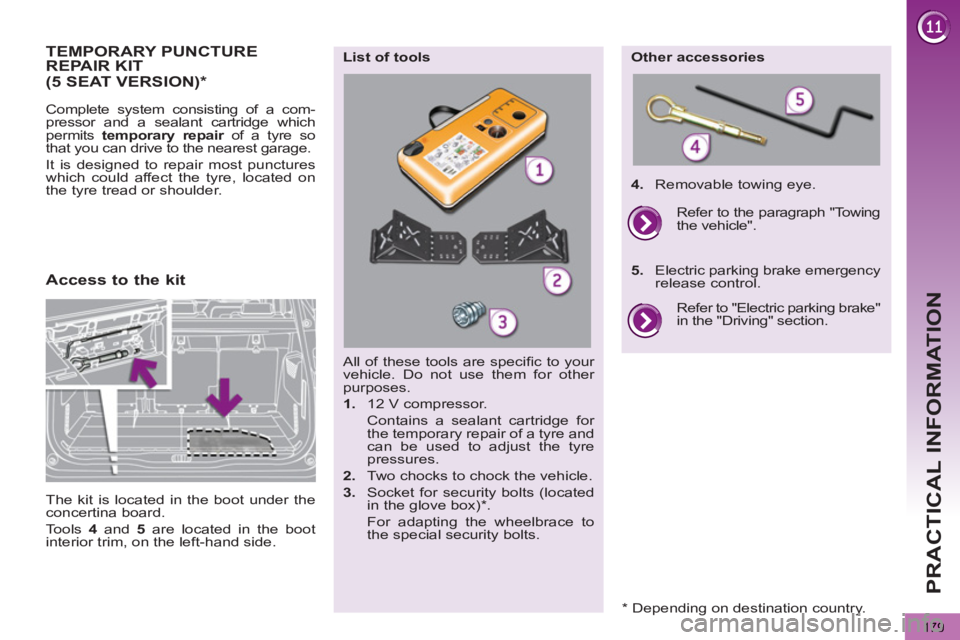
PRACTICAL INFORMATION
179
TEMPORARY PUNCTURE REPAIR KIT
Complete system consisting of a com-
pressor and a sealant cartridge which
permits temporary repair
of a tyre so
that you can drive to the nearest garage.
It is designed to repair most punctures
which could affect the tyre, located on
the tyre tread or shoulder.
All of these tools are specifi c to your
vehicle. Do not use them for other
purposes.
1.
12 V compressor.
Contains a sealant cartridge for
the temporary repair of a tyre and
can be used to adjust the tyre
pressures.
2.
Two chocks to chock the vehicle.
3.
Socket for security bolts (located
in the glove box) * .
For adapting the wheelbrace to
the special security bolts.
List of tools
Other accessories
4.
Removable towing eye.
Refer to "Electric parking brake"
in the "Driving" section.
Refer to the paragraph "Towing
the vehicle".
5.
Electric parking brake emergency
release control.
Access to the kit
(5 SEAT VERSION)
*
The kit is located in the boot under the
concertina board.
Tools 4
and 5
are located in the boot
interior trim, on the left-hand side.
*
Depending on destination country.
Page 182 of 340
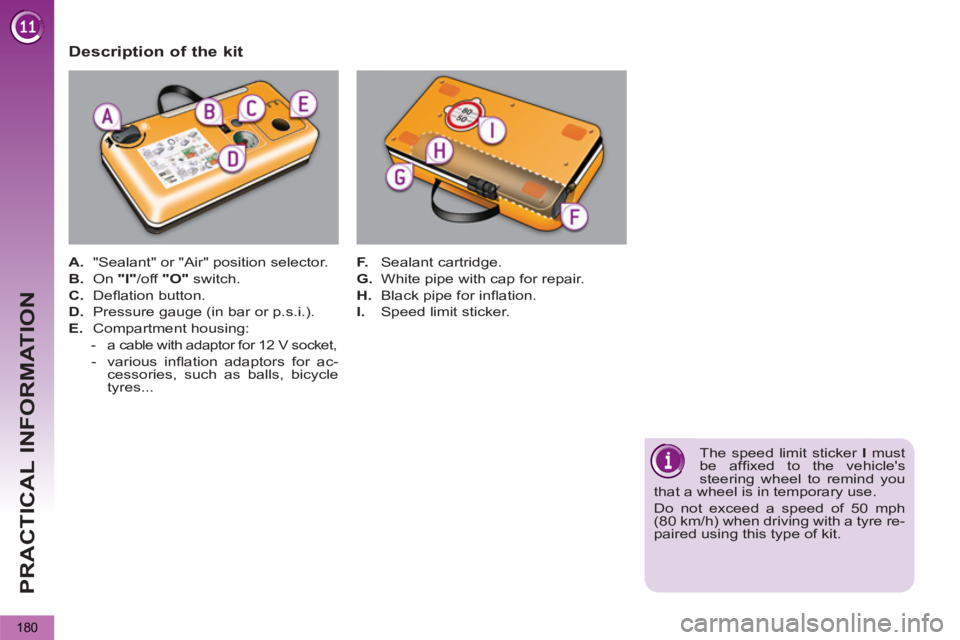
PRACTICAL INFORMATION
180
Description of the kit
A.
"Sealant" or "Air" position selector.
B.
On "I"
/off "O"
switch.
C.
Defl ation button.
D.
Pressure gauge (in bar or p.s.i.).
E.
Compartment housing:
-
a cable with adaptor for 12 V socket,
- various infl ation adaptors for ac-
cessories, such as balls, bicycle
tyres...
F.
Sealant cartridge.
G.
White pipe with cap for repair.
H.
Black pipe for infl ation.
I.
Speed limit sticker.
The speed limit sticker I
must
be affi xed to the vehicle's
steering wheel to remind you
that a wheel is in temporary use.
Do not exceed a speed of 50 mph
(80 km/h) when driving with a tyre re-
paired using this type of kit.
Page 184 of 340
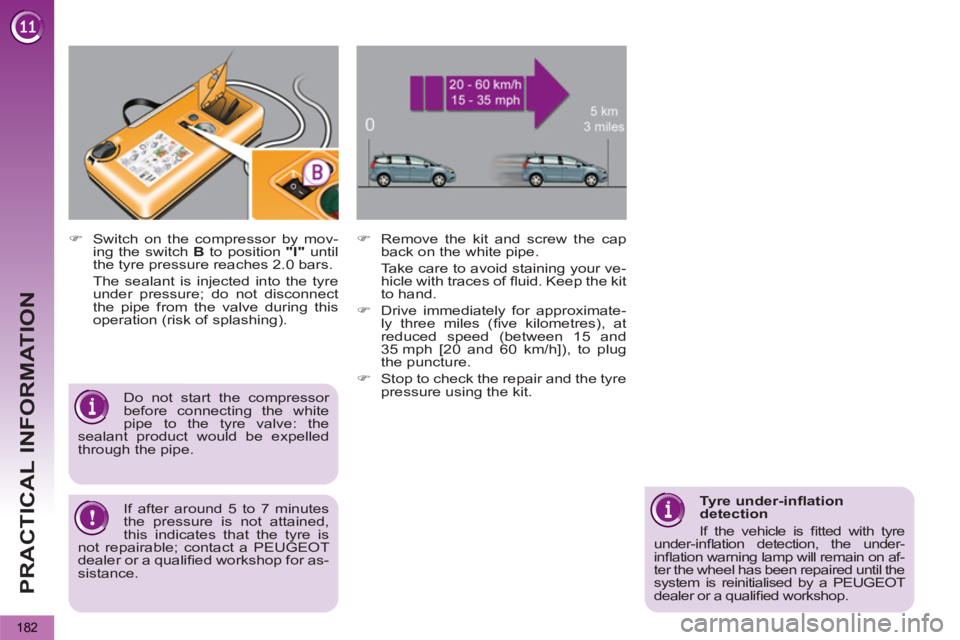
PRACTICAL INFORMATION
182
�)
Switch on the compressor by mov-
ing the switch B
to position "I"
until
the tyre pressure reaches 2.0 bars.
The sealant is injected into the tyre
under pressure; do not disconnect
the pipe from the valve during this
operation (risk of splashing).
�)
Remove the kit and screw the cap
back on the white pipe.
Take care to avoid staining your ve-
hicle with traces of fl uid. Keep the kit
to hand.
�)
Drive immediately for approximate-
ly three miles (fi ve kilometres), at
reduced speed (between 15 and
35 mph [20 and 60 km/h]), to plug
the puncture.
�)
Stop to check the repair and the tyre
pressure using the kit.
Do not start the compressor
before connecting the white
pipe to the tyre valve: the
sealant product would be expelled
through the pipe.
Tyre under-infl ation
detection
If the vehicle is fi tted with tyre
under-infl ation detection, the under-
infl ation warning lamp will remain on af-
ter the wheel has been repaired until the
system is reinitialised by a PEUGEOT
dealer or a qualifi ed workshop.
If after around 5 to 7 minutes
the pressure is not attained,
this indicates that the tyre is
not repairable; contact a PEUGEOT
dealer or a qualifi ed workshop for as-
sistance.
Page 185 of 340
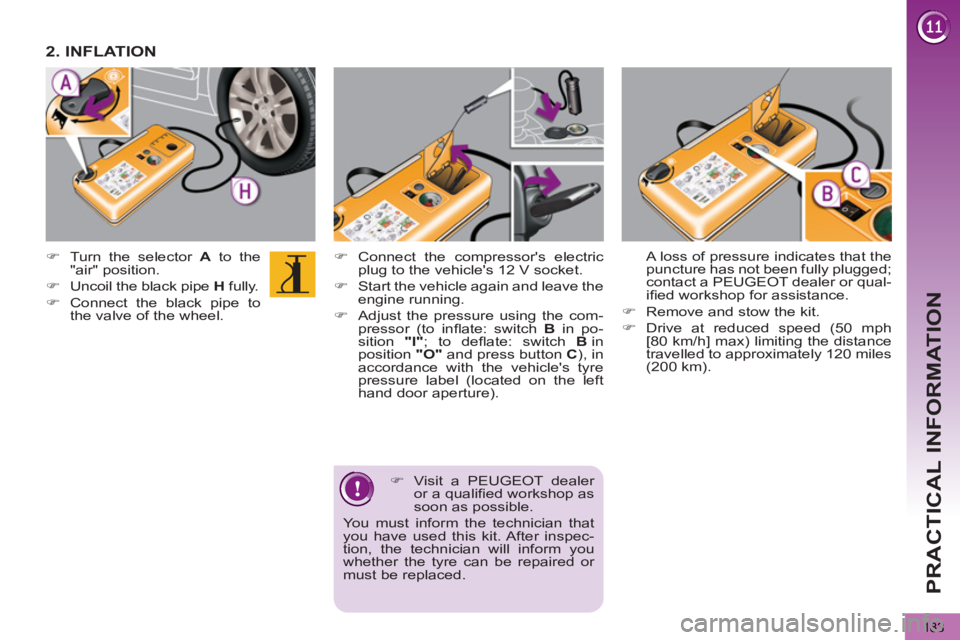
PRACTICAL INFORMATION
183
�)
Connect the compressor's electric
plug to the vehicle's 12 V socket.
�)
Start the vehicle again and leave the
engine running.
�)
Adjust the pressure using the com-
pressor (to infl ate: switch B
in po-
sition "I"
; to defl ate: switch B
in
position "O"
and press button C
), in
accordance with the vehicle's tyre
pressure label (located on the left
hand door aperture).
�)
Turn the selector A
to the
"air" position.
�)
Uncoil the black pipe H
fully.
�)
Connect the black pipe to
the valve of the wheel.
�)
Visit a PEUGEOT dealer
or a qualifi ed workshop as
soon as possible.
You must inform the technician that
you have used this kit. After inspec-
tion, the technician will inform you
whether the tyre can be repaired or
must be replaced.
2. INFLATION
A loss of pressure indicates that the
puncture has not been fully plugged;
contact a PEUGEOT dealer or qual-
ifi ed workshop for assistance.
�)
Remove and stow the kit.
�)
Drive at reduced speed (50 mph
[80 km/h] max) limiting the distance
travelled to approximately 120 miles
(200 km).
Page 186 of 340
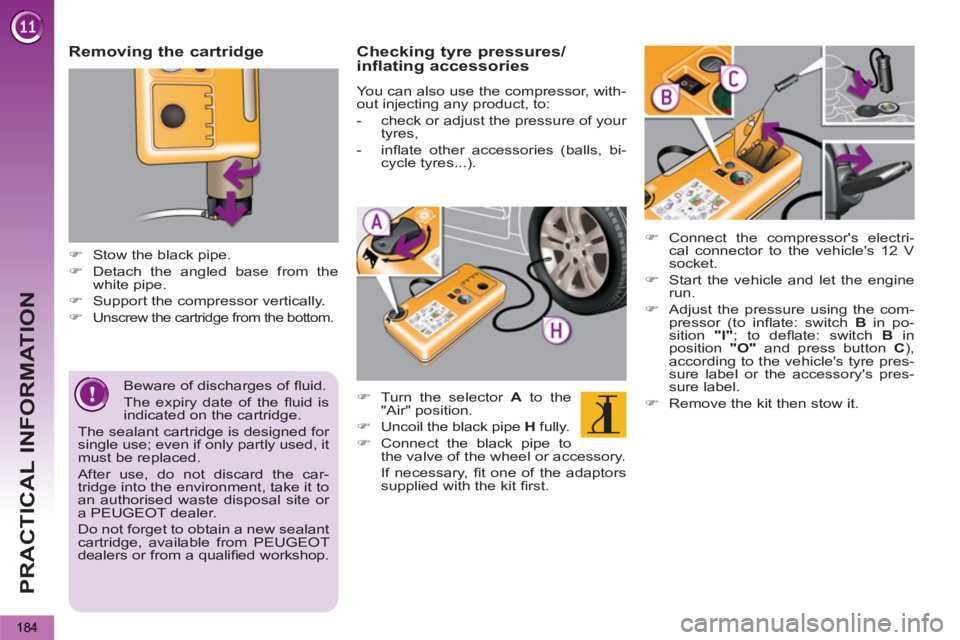
PRACTICAL INFORMATION
184
Beware of discharges of fl uid.
The expiry date of the fl uid is
indicated on the cartridge.
The sealant cartridge is designed for
single use; even if only partly used, it
must be replaced.
After use, do not discard the car-
tridge into the environment, take it to
an authorised waste disposal site or
a PEUGEOT dealer.
Do not forget to obtain a new sealant
cartridge, available from PEUGEOT
dealers or from a qualifi ed workshop.
Removing the cartridge
�)
Stow the black pipe.
�)
Detach the angled base from the
white pipe.
�)
Support the compressor vertically.
�)
Unscrew the cartridge from the bottom.
Checking tyre pressures/
inflating accessories
You can also use the compressor, with-
out injecting any product, to:
- check or adjust the pressure of your
tyres,
- infl ate other accessories (balls, bi-
cycle tyres...).
�)
Turn the selector A
to the
"Air" position.
�)
Uncoil the black pipe H
fully.
�)
Connect the black pipe to
the valve of the wheel or accessory.
If necessary, fi t one of the adaptors
supplied with the kit fi rst.
�)
Connect the compressor's electri-
cal connector to the vehicle's 12 V
socket.
�)
Start the vehicle and let the engine
run.
�)
Adjust the pressure using the com-
pressor (to infl ate: switch B
in po-
sition "I"
; to defl ate: switch B
in
position "O"
and press button C
),
according to the vehicle's tyre pres-
sure label or the accessory's pres-
sure label.
�)
Remove the kit then stow it.